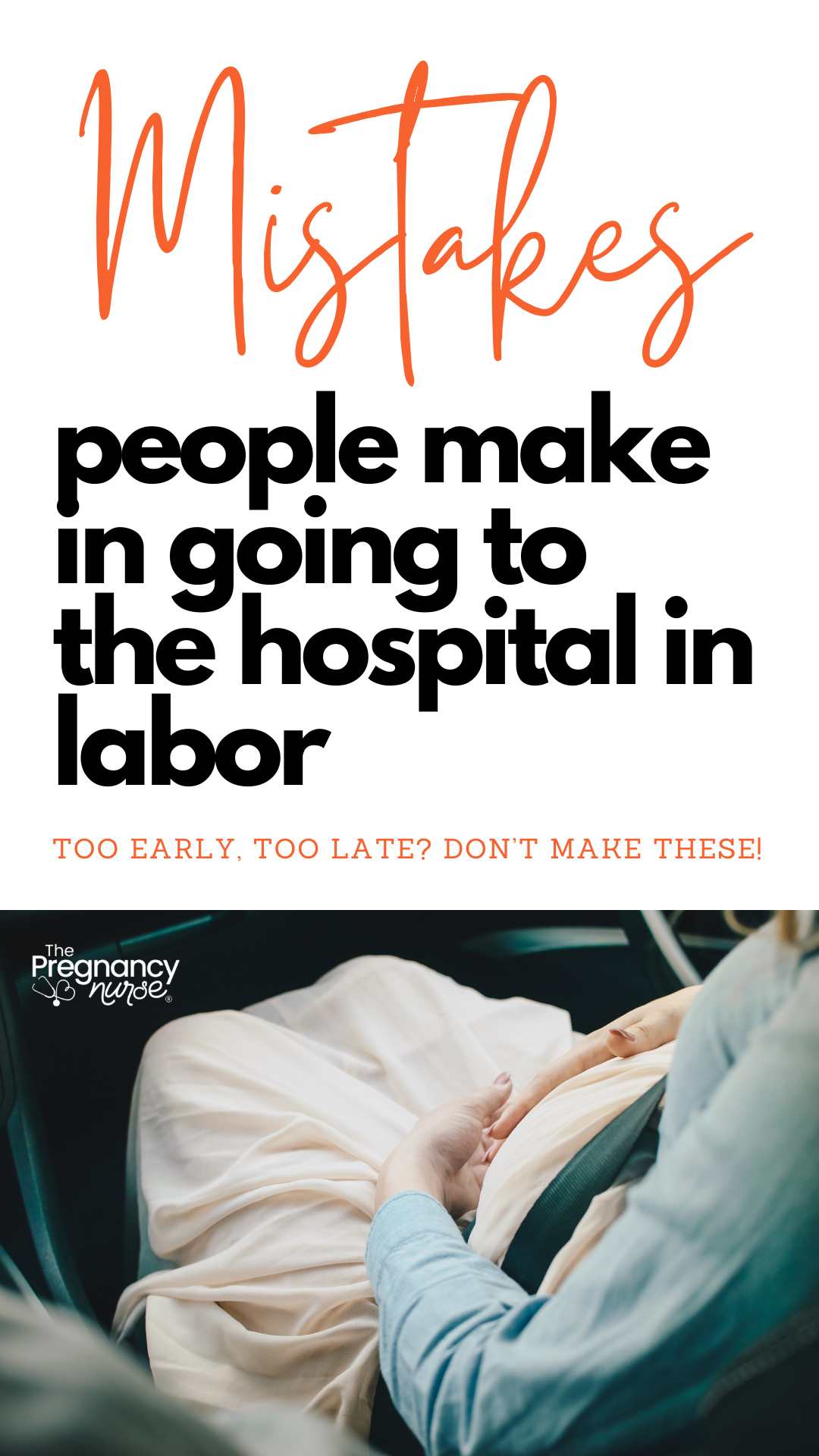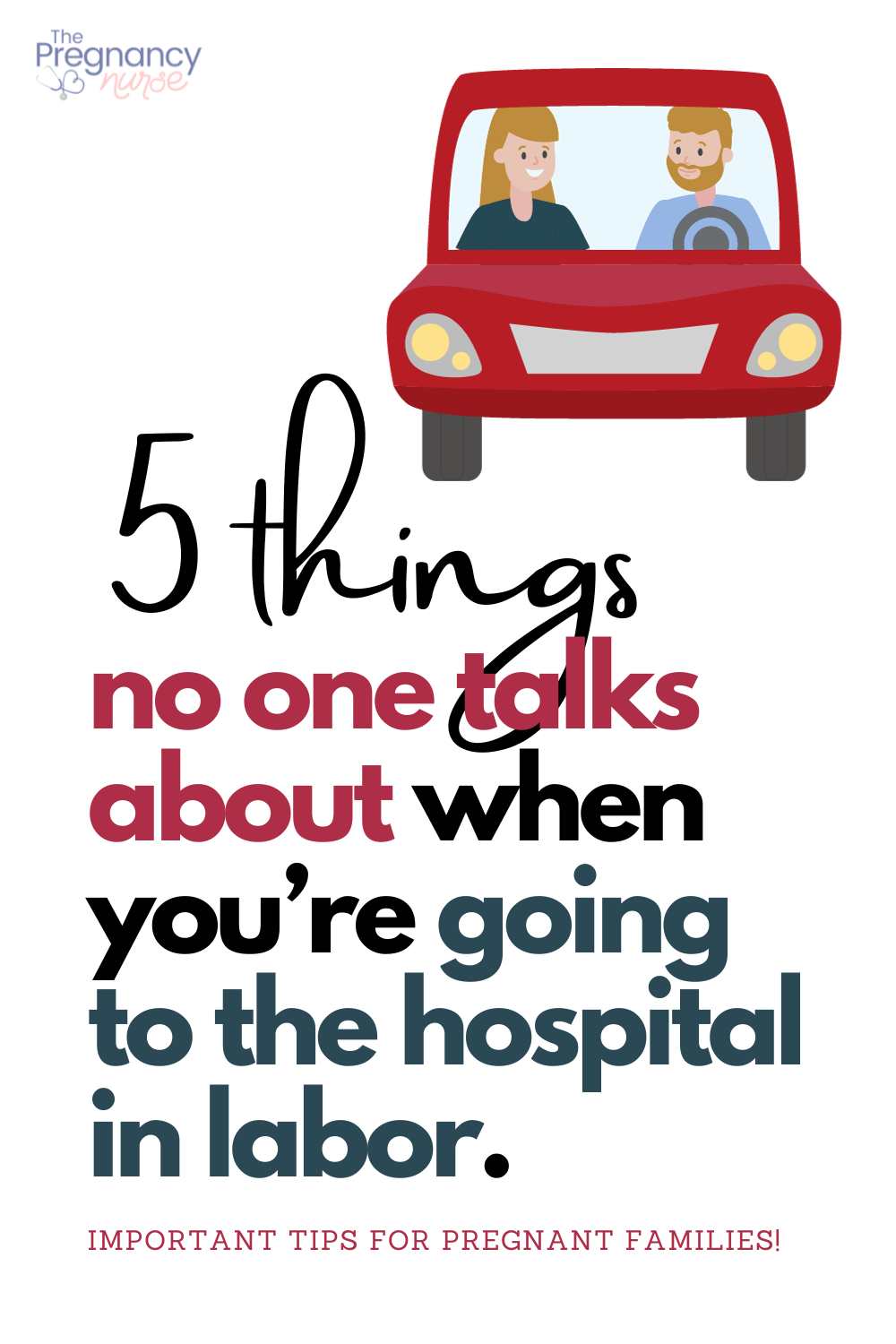👋 I’m so glad YOU are here. Are you looking to also get your partner prepared? This is for BOTH of you. Couples just love it and I know you want to both feel prepared!
A lot of people want some clear-cut guidelines about when they should go to the hospital when they’re in labor. I think that’s smart, because you don’t want to get there far too early and be miserable in latent labor in the hospital setting. But there’s a lot of things people DON’T talk about in this important topic. so, today I’ll address them for you!
But, how do I know so much about going to the hospital in labor? Hi, I’m Hilary — I’m The Pregnancy Nurse® (and the curly head at Pulling Curls). I’ve been a nurse since 1997 and I have 20 years of labor and delivery experience. I’ve seen a LOT of people who are worried about getting to the hospital on time and I have some MORE things to think about when you do that “magic equation”.
Pro Tip: I get super tired of the “magic equation” that people give online that is supposed to work for ALL pregnant people. There is a WHOLE lot more to think about, so I’m excited to give you these tips!
And yes, if you like true tips like this, come join me in here where we get you prepared for all of it!
Things to think about when deciding to go to the hospital in labor:
Traffic/Distance
This is NEVER talked about online and as more L&D units close and traffic increases in metropolitan areas it is really important to consider.
I used to work in a hospital that had HORRIBLE traffic around it. It was right near a busy interchange and a mall and it was just a mess.
I really think people needed to add an extra half hour (depending on the time of day) for the traffic around that area. We would get calls of people close to the hospital saying they hoped they’d make it due to just such a thing. We’d often send a nurse down with a wheelchair to meet them!
So, do some test drives to the hospital, ask your provider what traffic in the area is if you have a question about it (believe me, they know).
AND if your hospital is far away (I’m hearing a lot of people even in the US have to travel an hour or more to their hospital) it really makes this hard. I might even consider getting a hotel room nearby where you could go in early labor and then actually head to the hospital when you’re ready.
Talk with your provider if that’s you. And, my heart goes out to you. That’s tough and I hope that changes.
Your provider is going to be your best bet to combine all of these things for you. Have really frank discussions with them about what you should be seeing before heading in. They really don’t want you there too early either.
Previous History
How long were your previous births, and how many have you had?
While previously having had a baby doesn’t really decrease your early labor time, it can make the 2nd and 3rd stage much faster. If you went fast the first time, you may go fast this time (although I pushed longer on my second baby, because he was bigger — so you never know).
When you talk with your provider mention your previous history when discussing your plans. Or, if you call in to talk with someone in their office when you’re in labor mention your previous history as well.
If you had a very fast labor last time, it can be a reason to have an induction on your next baby to make sure that you’re in the hospital setting. So talk with your provider (although they usually won’t go too early for this reason).
GBS Status
Your provider will check your GBS status about a month out from your due date. If you’re found to be positive they’ll prefer that you’re at the hospital about 5 hours before baby is to be born so that you can have the antibiotic infusion to clear-up this issue.
Those antibiotics need to be IN your system for 4 hours before baby is born to do their thing (which means you need to come in, get on the monitor, we put the IV in etc — so 5 hours is a good “safe” minimum time).
So, that’s something to consider as well. I often wonder why people can’t just go on oral antibiotics, but you really need that huge GUSH of antibiotics to just CLEAR that bacteria from the birth track (and then it all returns once we stop them).

Parking
Hospitals are MONSTROUS anymore and sometimes parking can be far away — even for people in labor.
I actually recommend this as one of the MOST important reasons to take a hospital tour. They can show you where to park if you’re in labor and what the best route to the unit is.
If your hospital doesn’t offer in-person tours, they should have something on their website or some information you can have to get to them safely.
BUT some hospital just take a while to get up to the unit, and that needs to be factored in as well.
Anxiety
Your anxiety at home is a big factor in heading into the hospital too early. And frankly, not just YOUR anxiety but your partner’s anxiety as well.
Things that can help:
- Knowing what the stages of labor look like (a roadmap to birth)
- Things you can do at home to help labor progress
- Things you can do to help pass the time
- How to incorporate both movement and sleep during this time
This class can really prepare you for all those things, plus the delivery and postpartum life as well! It truly is the EASY way to get prepared!

What’s the problem with going to labor and delivery too early?
Now, you’re probably better safe than sorry. And while I am a believer in that…. here’s some facts:
- They may send you home if you’re not progressing — the hospital is a place for active labor. If your cervix isn’t actively opening they may just send you home, and while that isn’t the end of the world I think most people would prefer to avoid that if possible.
- They may try to augment you — the hospital wants to see ACTIVE dilation. So, if you get there, and they admit you but you’re stuck at a 4 for a few hours (which isn’t unusual at all) your provider may want to give you some Pitocin to speed things along. Also not horrible, but it’s not what a lot of people want.
- Hospital slows oxytocin. At home you’re going to have all your things, and your smells, and your food and the love that your home just HAS. In the hospital we’re unfamiliar, we have bright lights and we throw on monitors that may limit your movement.
I’m just a huge believer in this fact: The hospital is the best place for people in active labor. So, the longer you can manage early labor at home on your own the better off you will be.
Active labor is usually defined from about 4-6 cm when your cervix is starting to open about 1 cm/hour. So, if we check you now, you should change in an hour from now.
But I also think you can stay in touch with your provider during that timeframe. Often, experienced providers can tell in your voice when it’s time to come in. 🙂 Providers should have someone who answers calls for them 24 hours/day so you can stay in touch with them. Ask your provider about that at your next appointment!
Things that don’t factor in:
Your previous cervical exam. Unless you’re already walking around at 6 cm dilated, the fact that you were 2 cm in the office doesn’t really change the plan. That may put you into active labor faster, but you’re still looking for specific things (which you’ll discuss with your provider) that make you think it’s time to head in.
Remember, labor isn’t JUST contractions, usually it’s a whole lot more — so grab my labor signs checklist so you’re prepared:
How do know when to go in?
It seems great to have a magic equation based on your # of baby and the contractions as to when you should go to the hospital.
Personally, I recommend not even TIMING the contractions til’ they’re mostly less than 10 minutes apart. When you’re starting to get to 5 minutes that’s when you start to call your provider and get some input from them.
If you’ve already had a baby they may tell you to come in at that point, and if you are on your first they may give you some tips to labor at home a bit longer.
But the key is talking with your provider who is balancing all those things I mentioned above — there isn’t a “one size fits all” equation as to when to go to the hospital. I hope you understand that now.
BUT, knowing those stages of labor can be really comforting and give you confidence that you’re doing the right things at home.
PLUS having some tips on what to DO at home is a GREAT plan for both of you. I give you those tips in here. Things like movement, eating, all that jazz are things that can help labor progress in the easiest way possible. The Online Prenatal Class for Couples really is the easiest way to get prepared for birth!
And, if you’re not quite sure you’re ready for that whole thing, check out my free prenatal class. It’s your first step toward getting in the driver’s seat of your birth.









 Reason You’ll Want a Birth Class on Your Second+ Baby
Reason You’ll Want a Birth Class on Your Second+ Baby
